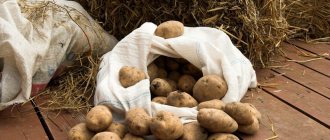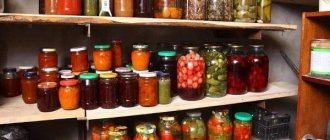Harvesting and preparing potatoes for storage
You should start harvesting potatoes in late August - early September.
By this time, the vegetables have ripened, stopped peeling and are ready for long-term storage. Do not delay harvesting, as digging during the rainy season will negatively affect the shelf life of the product. High humidity will lead to rapid deterioration and rotting of tubers.
The period of preparing potatoes for storage is divided into the following mandatory stages:
- "air-sun bath" Duration – 1-2 hours. This is done immediately after digging so that the skins of the root crops dry. If the day is very sunny, stop the procedure as soon as possible so that the tubers do not get sunburn;
- "healing". The potatoes should lie under a canopy, scattered in a thin layer. During this period, the tubers actively “breathe”, simultaneously increasing the thickness of the skin and maximizing its protective properties. Minor damage to the peel heals; it accumulates substances that prevent the penetration of pathogenic microorganisms. Duration - about 2 weeks at an optimal temperature of +13...18 ℃ and humidity 90-95%. If the weather is cooler, this stage is extended to 3 weeks;
- "falling asleep" In the next 10-15 days, the temperature under the canopy where the potatoes lie should gradually decrease to +2...4 ℃ (in normal autumn this is what happens). During this time, the tubers gradually fall into a state of complete dormancy. All active biological processes in them stop.
Ideally, the period from digging to storage takes about 4 weeks. You need to make sure that during this time the tubers never get wet. If there is prolonged rain, the potatoes are covered with clean burlap or straw.
After harvesting, the potatoes should be dried in the sun for a couple of hours, and then under a canopy in a well-ventilated area for several weeks.
Next, seed potatoes . These are the best, smooth and beautiful tubers of medium size and slightly smaller. Before storing, they are kept in the sun for several days so that the peel accumulates solanine. It is poisonous to people, but it protects root crops from rodents, promotes better storage and more active germination after planting.
The remaining tubers must be sorted by size. Medium-sized root vegetables store best and longest. Large ones are recommended to be used up before mid-winter: with longer storage, their taste deteriorates, and voids often form inside. Therefore, when storing in bags or boxes, containers with large tubers are placed in the cellar closer to the exit. Potatoes that are small or damaged during digging are left for immediate use in the fall.
For long-term storage, choose potato varieties that have high shelf life and are recommended by experts as table potatoes (“Lorch”, “Nevsky”, “Red Scarlet”, “Tuleevsky” and others).
In addition, it is important to understand that the success of storing root crops is greatly affected by the condition of the soils in which they were grown. Therefore, novice summer residents should sometimes take into account the opinion of their more experienced neighbors and buy for cultivation for storage not just another advertised “super-fashionable” variety, but “local” seed potatoes that have proven themselves well in this sense.
For potatoes, the concepts of “early” and “late” do not refer to the duration of storage, but to the possibility of obtaining root crops that are suitable for consumption and correspond to varietal parameters early (for the middle zone - at the end of July) or later (at the end of August). The possibility of long-term storage is determined by the concept of “keeping quality” . It depends not so much on the timing of root crops reaching technical ripeness, but on the content of starch and other components in their pulp, and in the skin - substances that increase its protective properties.
Preparation for storage
Let's look at several steps to prepare fruits for storage.
Air-sun bath
If the weather is good, the tubers are scattered to dry on the arable land; in rainy weather they are taken under a canopy. The potatoes are kept in the sun for no more than 2 hours, then dried for 2 weeks in a barn or under a canopy. Ultraviolet rays, they make up 10% of the spectrum of sunlight, have a bactericidal effect, kill fungi and bacteria, and increase the shelf life of potatoes.
Healing
It is impossible to avoid mechanical damage during digging. Infection can occur through wounds on the skin. They dry out quickly and become covered with dry skin at a temperature of 13-18 °C. Healing takes no more than 2 weeks. If the temperature is lower, the process is delayed up to 3-4 weeks.
Falling asleep
Before being sent for storage, the tubers must undergo a period of gradual cooling. In industrial potato storage facilities, the temperature is reduced daily by 0.5 °C. The process lasts 10-15 days. The weather helps the summer residents. When the air temperature drops to 2-4 °C, the potatoes are sent for storage. Thanks to the gradual decrease in temperature in the tubers, all processes (physiological, biochemical) stop.
Sort
Large ones are for food, medium ones are for planting next year, small ones are for animal feed or destruction.
Select affected tubers
Rotten, diseased tubers infected with a fungal bacterial infection must be destroyed so that the diseases do not spread.
Remove soil and dry properly
Do not dry potatoes in the sun: they may turn green. Choose a place in the shade or in a dark room. The tubers need to be kept in a scattered state for 7-12 days so that they are completely dry and ready for long-term storage.
Wash in manganese aqueous solution
This procedure is not necessary, but it helps to significantly improve the preservation of tubers. I always do this. I pour warm water into 2 basins and dissolve manganese in it until it turns bright pink. I wash the potatoes first in one basin, then in another. Afterwards, you need to dry the tubers very well, scattering them so that they do not touch each other and turning them over every day.
Potatoes washed in manganese last all winter, “like new.” It is pleasant to use because it is clean and does not rot.
Optimal conditions for storing potatoes
Seasonal vegetables are available all year round, and many housewives simply buy potatoes as needed in small quantities and store the product on the refrigerator shelves, pantry or cupboard. But if you harvest on your own plot, where there is no cellar, or buy several nets for storing potatoes in an apartment, you need to observe optimal conditions under which the product does not lose nutritional value and does not spoil. If you place the potatoes correctly, the storage time of the tubers increases noticeably. It is necessary to maintain the recommended temperature and humidity, store vegetables in a well-ventilated area, periodically check for rot, and remove sprouts. How to store potatoes for the winter in an apartment for a long time? Provide optimal storage conditions for vegetables.
Humidity
Fungus occurs when there is high humidity. If the humidity is below normal, the tubers change structure and become flabby. The optimal level is 80%.
Storing potatoes at home in an apartment should be based on maintaining optimal air humidity in the room - 80-90%. High humidity plus heat is a signal for the germination of young shoots that dry out the root crop. How to get the optimal humidity level:
- Ventilate the storage area periodically.
- Provide vegetables with good air circulation.
- Do not keep potatoes in places where moisture evaporates.
- Do not store boxes near walls where condensation collects.
- To absorb moisture, cover the tubers with sawdust.
- Do not store root vegetables with any other vegetables except beets.
If you store potatoes in the kitchen, you need to make sure that the hood above the cooking stove works well. When condensation settles on potato skins, the tubers deteriorate and young sprouts may sprout.
Temperature
The optimal temperature range is from +3 to +5 °C. If the temperature is higher than this, the potatoes will last no longer than 3 months and will quickly begin to germinate. Due to low temperatures, root vegetables become sweet in taste and rot from the inside.
Potatoes do not like heat; coolness increases the shelf life of tubers. Even at the stage of sorting vegetables, you need to separate damaged and small root vegetables for use first, select large tubers - they will last until mid-winter, and leave medium-sized vegetables for long-term storage. The optimal temperature for storing potatoes in winter is considered to be 2-3°C, but the apartment is much warmer. How to achieve the desired reading on the thermometer:
- In autumn, potatoes can be stored on the balcony, but do not allow light to enter.
- When the temperature drops to -2 degrees Celsius, bring the crop into the room.
- Choose the coolest places in the room and leave the container in the vestibule.
- Do not store tubers near heating appliances or radiators.
- Check the temperature periodically by leaving a thermometer in the box with the potatoes.
How to save potatoes for planting in an apartment
Not all the potatoes collected are used for food. At the sorting stage, tubers are selected from the entire harvest to be used for cooking in the fall and winter. But some of the collected potatoes must be left for next year in order to plant them in the garden. Especially if the harvest from these bushes impressed you. For these purposes, you need to choose smooth, dense tubers that are not too large in size. Make sure that there are no traces of a shovel or fork on them, otherwise the potato itself will get sick and infect all its neighbors. Experienced gardeners know that temporary exposure of vegetables to the sun will help extend the shelf life. Just a few hours are enough for solanine to begin to be synthesized. In large quantities it is dangerous for the digestive tract, but in small doses it creates natural protection against pathogenic microorganisms.
To select seed potatoes for home storage, you must adhere to the following recommendations:
- Do not try to choose the largest tubers; their size should not be gigantic, otherwise they may not last until planting.
- Do not rush to quickly put seed potatoes into storage containers. It is best if she lies in the fresh air for a couple of weeks. Then the tuber will dry out and produce the required amount of solanine.
- Potatoes do not like heat; they thrive at temperatures of +4...+7 °C. But you need to come to them gradually, lowering the temperature by several degrees every day.
- Until the first frost, seed potatoes will lie on the balcony or loggia without any problems.
- To prevent too much moisture from accumulating, you can place a layer of beets on top of the potatoes. Its structure is designed so that the surface of the vegetable is able to absorb all excess moisture.
As soon as the night temperature outside begins to drop below zero, the crop must be brought into the house. Just don't place the box near the battery. Remember - potatoes love cool weather.
Recommended: Tennis Court Maintenance and Repair - Top 10 Things You Should Know
Too often, potatoes do not need to be moved from place to place and mixed, but periodically it is necessary to inspect the tubers for the appearance of rot. Young shoots that appear must be removed in a timely manner, and about a month before planting, on the contrary, their growth must be stimulated. To do this, vegetables are placed in a warmer place, it is advisable to increase the temperature daily by 1-2 degrees. The better the germination (i.e., the more sprouts sprout), the better the potatoes will take root and the more harvest will be harvested.
Storing potatoes at home
In a city apartment, you can store potatoes on a balcony or loggia. For containers, use sealed boxes with a double bottom and walls. To protect against freezing on a cold balcony, insulate the inside of the container with polystyrene foam. Cover the top of the box with a lid or a dark, warm cloth to protect the tubers from light.
To avoid rotting and sprouting of produce, place rowan or mint . Such plants not only help maintain optimal humidity, but also destroy pathogenic microorganisms due to the released phytoncides.
The following will also help against rotting tubers: onion peel , dried herb , wormwood , fern , elderberry leaves .
You can transfer the tubers with pine paws or store the potatoes in boxes made from fresh spruce or pine boards.
It is very useful to keep potatoes and ginger root (both keep better).
If you want to store a large amount of crops on the balcony in winter, prepare a special chest where the optimum temperature and humidity will be maintained. How to do it correctly, watch the video:
You should store potatoes at home in the summer in the pantry or under the kitchen sink. To do this, place the vegetables in a wicker basket, plastic box or perforated bucket. The shelf life of potatoes in such conditions is 14 days.
There is an opinion that you should not use plastic bags or polypropylene bags for storing potatoes (they do not allow air to pass through, which leads to rapid rotting and spoilage of the product). But if the potatoes are prepared for storage according to all the rules, then the average number of tubers (up to 20 kg) can be kept for 3-4 weeks at room temperature in a plastic bag . Conditions: the bag must be thick, dark and very well tied (for example, garbage bags). The main thing is not to open the package “in between” and not to disturb it at all. In a city apartment, you can store potatoes under the sink in a wicker basket, wooden or plastic box. You can also organize storage on a balcony, loggia or in the entrance corridor
Storing potatoes in the refrigerator
Many housewives are concerned about the question: is it possible to store potatoes in the refrigerator? The refrigerator maintains optimal temperature and humidity, making it suitable for storing potatoes. However, remember the significant drawback of this method - limited space does not allow you to save much harvest.
To store potatoes in the refrigerator, place the potatoes in a paper bag and place it in the crisper drawer . In such conditions it can persist for up to several months. The refrigerator is ideal for storing finished potatoes - boiled, baked in jackets or stewed. This allows you to make preparations for the morning or for several days.
Sometimes housewives need to preserve peeled potatoes. To do this, place the tubers in a container and fill with cool water. You can store peeled potatoes at room temperature for 2-4 hours, and in the refrigerator for 2 days.
How to store potatoes in the cellar
The optimal place to store potatoes is a cellar, the basement of a private house or a special vegetable storage. In such rooms, suitable temperature and humidity are maintained, and they are completely protected from sunlight.
Before storing potatoes, prepare the room:
- dry the cellar well and insulate it if necessary;
- disinfect the premises, destroy rodents and other pests;
- Hang a thermometer and hygrometer to monitor air temperature and humidity and maintain a favorable microclimate.
When storing potatoes, it is important to choose the right container. The ideal option is wooden boxes or nets (woven or “sugar” bags are not recommended). You can also store potatoes simply in a mound up to 1.5 m high. It is better to store potatoes in the cellar in wooden boxes or nets. It is important that the crop is well ventilated, and that the room has optimal humidity and temperature indicators
You can store potatoes next to beets - they will absorb excess moisture and prevent the product from rotting. But it is not recommended to place potatoes next to cabbage, as this will lead to rapid spoilage of the vegetables.
How long can you store potatoes in the cellar? If all recommendations are followed and a favorable microclimate is created, the vegetable will be stored for 8-10 months.
How to store potatoes in an apartment
Potatoes require proper storage conditions during the winter.
There are several popular methods for preserving the beneficial properties of potatoes at home. Four methods are ideal for storing vegetables in your apartment.
Kitchen storage
You can store potatoes in a dark and cool room. To do this, choose a place with an optimal humidity level. It is not recommended to pack vegetables in plastic bags or hermetically sealed bags.
Potatoes can be stored under the sink.
Wicker baskets, a wide bucket or basin are ideal. You will need to make several holes in the container to improve air circulation. In the kitchen, the best place for storage is in the cabinet under the sink.
Vegetables on the balcony
It is advisable to use a wooden box or box as packaging. The product must be made of natural material (timber, boards or pressed sawdust).
It is advisable to use a wooden box for storing vegetables.
You can store vegetables on an open balcony (without glass) using a protective coating. The box should be insulated with a material that has high insulating properties. Styrofoam is ideal.
The top of the box can be covered with old jackets, fur coats or a blanket. The foam material will not affect the quality characteristics of the potatoes. Warm clothes will help keep the heat inside the container.
How to store potatoes in the refrigerator
In old "Khrushchev" apartments, small cabinets are built under the kitchen windows. Previously, they were used to store non-perishable food products. The air temperature in the niche in winter changes according to the weather conditions outside. The thermometer reading is higher than outside the window and lower than indoors.
For control, you can build a thermometer on the shelf of the cabinet. Using the device, the need to insulate potatoes can be easily determined.
Vegetables can be placed in a niche under the kitchen window.
In new buildings, you can use cabinets made of high-quality plastic with a control device. The hole in the niche resembles the neck of a bottle. To decrease or increase the temperature, just turn the knob in the right direction.
The operating principle of the device is no different from other storage methods. A significant drawback of the technique is its small volume. The low capacity of the cabinet does not allow storing vegetables in sufficient quantities.
Potatoes in the hallway or entrance
In non-residential premises the temperature is much lower. Therefore, it is convenient to store vegetables in the service room. A convenient and capacious container should be provided. A bulky box can be a nuisance.
To store potatoes in the hallway or utility room, it is recommended to purchase a compact container or box.
Storing it in the entrance is quite risky. It is necessary to provide security measures. To do this, you can equip the box with a lock. It is recommended to fix the container on the floor.
It is necessary to take into account the humidity level in the room. Temperatures above +27 degrees can spoil potatoes. The vegetable will dry out. To monitor the water content in the air, place a psychrometer in the room or place an open plastic container near the storage area. The appearance of spots indicates an increased level of air humidity.
Additional information about storing potatoes at home can be found in the video:
Where is the best place to store potatoes in an apartment?
Storing potatoes in winter is one of the important issues that residents of apartment buildings have to solve. There are several methods that can be used to keep tubers in good marketable condition until the next harvest.
Before storing, you need to prepare the tubers:
- in appearance: potatoes should be dry, firm, with healthy skin (no spots or sprouts);
- by size and shelf life: the largest ones are stored for an average period (depending on the variety, up to 4–4.5 months); medium - up to 5–6 months; small ones, cut during harvesting, with damage, should be eaten before everyone else, having previously been taken into a separate container.
In the pantry
The pantry will serve as a good potato storage room at home if you properly prepare the room for receiving the harvest:
- Dry the room by ventilating or installing a fan heater.
- Whitewash the walls for disinfection, ventilate after treatment.
It is better to store potatoes in a wicker basket with a lid; if there is none , in a wooden box or metal container with a lid, having previously made holes for ventilation. Paper and woven bags are suitable. The most extreme way is to bulk it, but this way the potatoes will spoil faster.
And access to other products will be inconvenient. The difficulty of storing in a pantry lies in poor ventilation, a possible increase in humidity and temperature, which will lead to spoilage of the tubers and the rapid spread of rot.
In the corridor or entrance
The technical corridors are less heated, so vegetables are preserved better there. The negative point is the possibility of crop theft. If the entrance is guarded, then by equipping the box with potatoes with a strong lock, you can save supplies until spring.
Important! To prevent the potatoes from fogging, you need to cover the top layer with matting or burlap.
Storage in the vestibule
How to store potatoes in the entrance vestibule? People whose childhood was spent in communal apartments remember very well those huge wooden boxes along the long corridors, closed with heavy barn locks. This is how many people left their entire harvest for the entire winter.
Advantages of storing tubers in a vestibule
- It is always cool in the corridor (entrance) due to drafts from the open windows, but nevertheless the temperature in the vestibule in front of the apartment is much higher than outside. Thus, the ideal temperature is achieved for the preservation and good keeping quality of vegetables.
- Food supplies are nearby, you don’t have to go or travel anywhere, which is very convenient for a modern person.
- No special equipment or devices are required.
Disadvantages of tambour storage
- The weather outside often changes and, as a result, there are constant temperature changes in the entrance, and this, as is known, can lead to spoilage of fruits, the beginning of rotting or drying out.
- For storage throughout the season, this method is only suitable if the variety is good and the harvest is successful. When the potatoes are dug up, the tubers go into a state of physiological dormancy; this period lasts about 80 days and the tubers are not capable of germination even at a temperature of 19 degrees. But after this period of time, even if all conditions are met, by mid-March, and sometimes already in mid-February, seedlings appear.
- This method has one more feature - the spread of smell, not everyone will like it, problems with neighbors may arise, or your property may attract dishonest people.
On the balcony
A ventilated, less heated room in many apartments has a balcony. By making a mini-refrigerator made of wood or plywood with double walls and insulation, the potatoes are stored there all winter.
What other nuances need to be taken into account?
Organizing potato storage is a whole science. In addition to choosing the right place and creating optimal conditions, you need to know some of the subtleties of storing potatoes:
- Potatoes should not be kept next to other vegetables. It only tolerates proximity to beets.
- Tubers need to be sorted out from time to time, soft, rotten and with shoots removed. Otherwise, all the potatoes will spoil.
- Do not wash potatoes before storing, otherwise they will quickly rot.
- Wet potatoes must be dried naturally, placing the tubers at a distance from each other.
- When sprouts appear, the product should be eaten as quickly as possible before it softens and turns green.
- Different varieties of potatoes should be stored separately. The fact is that they all begin to deteriorate at different times, and deterioration is a spreading process. For example, early-ripening potatoes are usually stored until November. And if it is placed in one box for a long-term view, the entire harvest will deteriorate ahead of schedule.
Add a green apple, ginger root or a sprig of wormwood to the potatoes. These folk remedies help delay the germination of tubers and prevent rotting.
So, potatoes are usually stored in basements and cellars. Their conditions are considered the best. But you can arrange a suitable place inside the apartment. As an alternative to a cellar, a balcony, pantry, or space under the kitchen sink are often used. The main thing is to comply with all storage conditions: maintain the correct temperature, humidity, protect the tubers from light. Then the harvest will not spoil and will feed the whole family until spring.
The best varieties
Each variety of this root vegetable differs in starch content. If the potatoes are well boiled, this means that they have a fairly large amount of this substance. Foreign companies have special labeling, according to which the purpose of this root vegetable is adjusted. The least digestible variety is marked with the letter “A”. It is suitable for soups. The "B" variety is used for making potato chips, while the "C" variety is ideal for frying. When preparing mashed potatoes, naturally, you will need the most boiled type of potato, marked with the letter “D”. Root vegetables with a high starch content are best preserved.
For winter planting, as a rule, late-ripening varieties are used. These include such popular species as “crane fly”, “asterix”, “lorch”, “stonefly” and “picasso”.
How to increase the shelf life of potatoes
To preserve the tubers for a long period, there are several tricks:
- After purchasing or harvesting, you should not immediately store potatoes. “Quarantine” will show spoiled tubers for 10 days that need to be removed from the main quantity.
- Green potatoes cannot be stored: they contain poisonous solanine.
- Arranging vegetables with layers of pine needles and rowan leaves containing phytoncides will increase shelf life and preserve the appearance of the tubers.
- Dry wormwood, fern and elderberry, placed in bags or boxes, will also protect against the formation of rot.
- Applying mint leaves to the tubers slows down their germination.
- Ginger and beets feel better next to potatoes, at the same time removing excess moisture, reducing the risk of rotting.
Shelf life
When the starch contained in potatoes breaks down, the vegetable becomes unusable. In order to preserve the root crop for as long as possible, it is necessary to prevent premature decay. It is influenced by the state of fruit maturity, storage conditions and variety.
With careful care, early ripening varieties can be stored for 3–4 months. The preservation of species of medium and late maturity is determined by GOST. On average, this is 6-7 months, and the most resistant varieties can withstand up to 10 months of storage in compliance with all rules.
The safety of the grown crop is no less important than timely harvesting. Your work will be worth nothing if most of the potatoes are lost due to improper storage.
Now you know that by maintaining the optimal temperature, humidity level and providing good ventilation, you will be able to keep your potatoes intact, tasty and beautiful.
Possible mistakes
In order for potatoes to be stored all winter, it is important to avoid mistakes:
- do not fill the tubers without sorting and checking for diseases;
- do not dry out the air in the room where vegetables are stored: ventilate when the humidity rises, place a damp cloth or periodically spray walls that are too dry;
- do not leave potatoes even in an insulated box on the balcony in frosty weather; during this period they need to be moved to the apartment;
- Do not store vegetables in a plastic bag for a long time, this will lead to rot.
If stored correctly, potatoes will not lose their taste until a new harvest appears.
Potato boxes
Where are potatoes stored in the apartment? In a box that almost anyone can build. Please note that there should be two of them. One is smaller and the other is larger. The difference should be about 20 cm in length, height and width. Sawdust is placed at the bottom of the first box, and the walls are insulated with cotton wool. Vegetables are placed in a small box, which is placed inside the first one. Thanks to double protection, potatoes are not afraid of frost and can be stored not only in the apartment, but also on the landing. The basement of a multi-story building would also be a good option.











